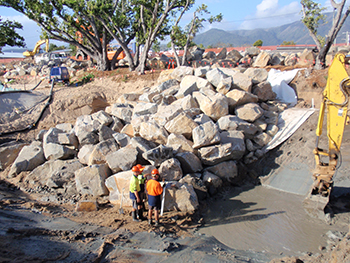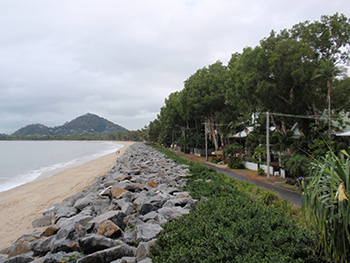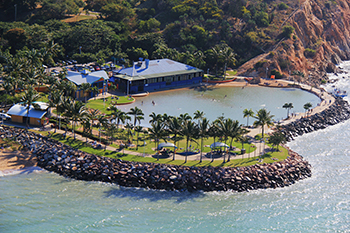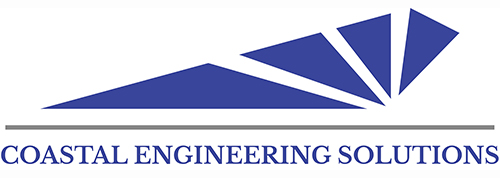 The construction of seawalls does not simply entail dumping rock on a foreshore. We often draw the parallel with the construction of a house. You don’t build a house by simply tipping a truckload of timber onto a vacant block of land. Individual components must be assembled appropriately so as to sustain external loads in order to fulfil the intended purpose of the structure. That is also the case for seawalls.
The construction of seawalls does not simply entail dumping rock on a foreshore. We often draw the parallel with the construction of a house. You don’t build a house by simply tipping a truckload of timber onto a vacant block of land. Individual components must be assembled appropriately so as to sustain external loads in order to fulfil the intended purpose of the structure. That is also the case for seawalls.
A properly designed seawall will provide robust protection to foreshore assets and require minimal commitment to future maintenance. Coastal Engineering Solutions has considerable expertise and experience in designing and supervising the construction of seawalls.
Design Life
Most seawalls are designed and constructed for a design life which would be specifically selected according to the intended purpose of the wall. Temporary works having a relatively short structural purpose would normally be a fairly simple design. Such structures may be removed or demolished when no longer required. A more permanent structure such as that fronting essential coastal infrastructure will typically have a longer design life of 25 to 100 years.
The design life of the structure would also be selected on economic aspects – such as the cost of replacing the seawall and/or the design life of the infrastructure it is protecting. Clearly the components of the seawall must have adequate durability to last to the end of its design life.
Design Event
 The selection of a Design Event is typically based on an acceptable probability of that event occurring within the length of time that the structure and its components are intended to serve their given purpose (ie. the design life of the structure). The selection of an appropriate design event therefore becomes a decision that acknowledges and accepts a particular level of risk that this event (ie. the particular combination of wave conditions and ocean level that the seawall structure is required to accommodate) might be equalled or exceeded within the design life of the structure. Specialised studies may be required to establish the joint probability of these inter-related phenomenon.
The selection of a Design Event is typically based on an acceptable probability of that event occurring within the length of time that the structure and its components are intended to serve their given purpose (ie. the design life of the structure). The selection of an appropriate design event therefore becomes a decision that acknowledges and accepts a particular level of risk that this event (ie. the particular combination of wave conditions and ocean level that the seawall structure is required to accommodate) might be equalled or exceeded within the design life of the structure. Specialised studies may be required to establish the joint probability of these inter-related phenomenon.
The severity of the design event is quantified by assigning it an Average Recurrence Interval (also referred to as a Return Period). This is the average time that elapses between two events that equal or exceed a particular condition. For instance, a 100 year Average Recurrence Interval (ARI) event is one which is expected to be equalled or exceeded on average every 100 years over a very long period of time. However since such events occur randomly in any particular timeframe under consideration (rather than at precise regular or cyclical intervals), they have a probability of occurrence within that time.
Seawall Performance
The design of seawalls must mitigate against three fundamental mechanisms of failure – or indeed by any combination of these, namely:
- erosion of the armour layer – instigated when the rocks or concrete units on the front face of the wall are not able to withstand the forces applied by waves as they wash against the slope. The armour is effectively swept off the structure by the waves.
- by undermining – occurs when wave action causes scouring of erodible material at the toe of the armoured slope, causing it to be undermined and to then collapse (even though it may consist of large armour units that would otherwise not have been moved by waves).
- by wave overtopping – caused by waves that wash up over the top of the armoured slope and scour the material immediately behind the wall. The top of the wall is then no longer supported by underlying material and it collapses into the scoured area behind it – lowering the top of the seawall further, allowing greater overtopping, greater scour and rapid progression to structural failure.
Seawall components
 There are many types of components that can be used to construct robust seawalls. There have also been many that have been tried with varying degrees of success. Historically these have included:
There are many types of components that can be used to construct robust seawalls. There have also been many that have been tried with varying degrees of success. Historically these have included:
- rock – either as multi-layered, rip-rap or pitching
- concrete – as preformed reinforced or unreinforced units and slabbing
- concrete mattresses
- asphalt
- gabions
Since each has widely divergent advantages and disadvantages, the selection of an appropriate seawall type requires specialised coastal engineering advice. Coastal Engineering Solutions has considerable expertise and experience in designing and supervising the construction of seawalls.
Projects
- Cardwell Reconstruction Project – Seawall Design & Construction, Qld
- Hayman Island Seawall, Qld
- East Beach Seawall, Port Fairy, Vic
- The Strand Foreshore Redevelopment, Townsville, Qld
- Bastion Point Breakwater, Vic
- Port of Brisbane – Bund Re-armouring, Qld
- Boigu Island – Design & Construction of Seabee Seawall, Torres Straits
- Christies Beach Seawall Design, SA
- Mundy Creek Training Walls – Design & Construction, Qld
- Nelly Bay Breakwater – Structural assessment, Qld
- Davey Bay Seawall, Vic
- Clifton Beach Seawall, Qld
- Blairgowrie – Review of Groynes, Vic
- Port of Airlie Breakwater and Revetments, Qld
- Bund Protection Works, Ashburton North, Dampier, WA
- Surfers Paradise Foreshore Redevelopment, Qld
- Pebbly Beach Seawall Design, Qld
- Witton Bluff North – Seawall Upgrading, SA
- Flying Fish Point – Expert Testimony, Qld
- Point Nepean Seawall – design and construction supervision, Vic
- Thevenard Island Foreshore Protection, WA
- Brisbane Foreshore Parklands Project, Qld

